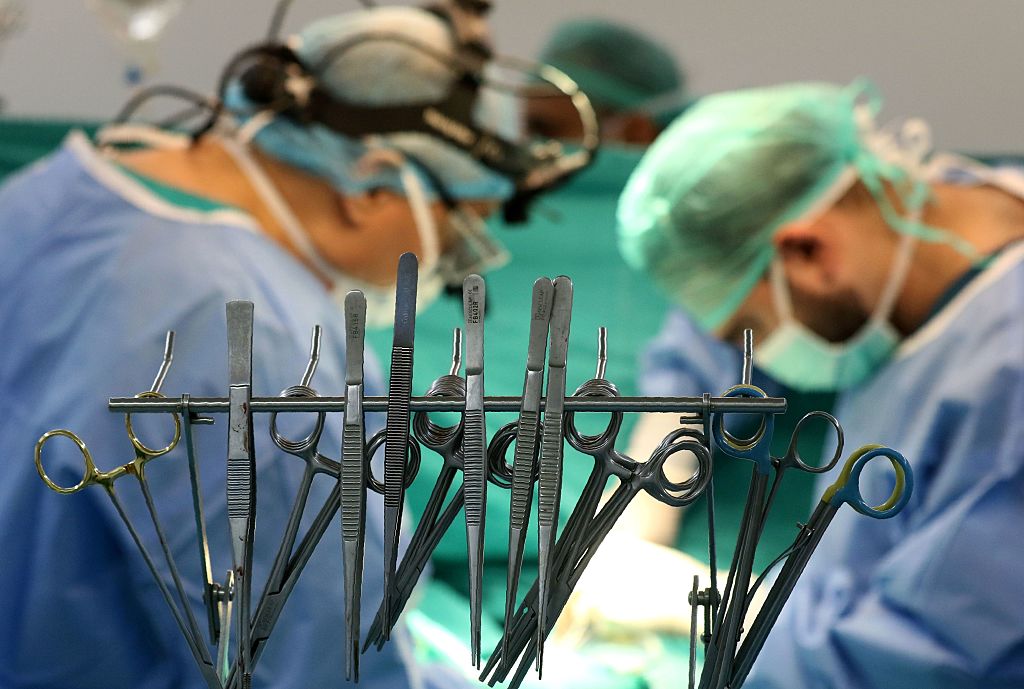No one wants to consider complications when they undergo surgery. Medical research shows even the most statistically safe surgeries come with risks. Unfortunately, these 16 common surgeries and procedures have high mortality rates. We’ll also take a quick look at why you should consider surgery.
1. Septal myotomy

 This surgery is quite complicated. | Daizuoxin/iStock/Getty Images
This surgery is quite complicated. | Daizuoxin/iStock/Getty Images
Mortality rate: 0.4%
Complications: irregular heart rhythms, blood clots leading to stroke, aortic valve problems, and removal of too much heart muscle
When done successfully, this surgery reduces the thickening of the heart muscles. The procedure is quite complicated, and you’ll have to spend time in the ICU if you survive. Fortunately, this surgery has a low mortality rate of only 0.4% in the first 30 days afterward.
Next: This surgery requires delicate physical reconstruction.
2. Esophagectomy

 Your family can also be your biggest support system when you consider surgery. | Megaflopp/iStock/Getty Images
Your family can also be your biggest support system when you consider surgery. | Megaflopp/iStock/Getty Images
Mortality rate: 6-7%
Complications: blood loss, pneumonia, and injury to the spleen or the trachea
An open esophagectomy, or esophageal resection, is a type of surgery in which a part of the esophagus or the entire esophagus is removed. The procedure carries a lot of risk due to the reconstruction of the area between the stomach and the healthy part of the esophagus.
Next: Experts deem this surgery the most burdensome.
3. Removal of part of the large intestine

 Serious operations can affect your emotions. | Shironosov/iStock/Getty Image
Serious operations can affect your emotions. | Shironosov/iStock/Getty Image
Mortality rate: 16.9%
Complications: heart attack, blood clots, and incisional hernia
The most burdensome emergency surgery involves removing part of the large intestine. The most common reason for this procedure is a symptom called volvulus, meaning the large intestine twists itself into a knot and creates a blockage.
Next: A staggering 42% of people see complications from this procedure.
4. Stomach ulcer surgery

 A common procedure many people undergo | PRImageFactory/iStock/Getty Images
A common procedure many people undergo | PRImageFactory/iStock/Getty Images
Mortality rate: 6.8%
Complications: recurring ulceration, iron deficiency, vitamin B12 deficiency, and folate deficiency
According to a recent study, 42% of those who had stomach ulcer surgery experienced complications. Luckily, surgery on stomach ulcers is much less common than it used to be.
Next: A little organ with scary surgery risks
5. Pancreatectomy

 A serious risk to consider | AlexRaths/iStock/Getty Images
A serious risk to consider | AlexRaths/iStock/Getty Images
Mortality rate: 5-10%
Complications: delayed gastric emptying and pancreatic fistula
Having your pancreas removed is a pretty risky procedure. While the mortality rate has decreased in recent years, you may still experience complications.
Next: Recovery is extremely painful after this procedure.
6. Spinal osteomyelitis surgery

 Elderly man with a backache | iStock.com/SIphotography
Elderly man with a backache | iStock.com/SIphotography
Mortality rate: 6.9%
Complications: secondary infection
Antibiotics take care of most spinal infections, so requiring spinal osteomyelitis surgery is quite unusual. However, when you need it, the complex procedure will remove the spine’s infected disk or disks. And recovery is painful.
Next: Dieting may not be enough for people considering this surgery.
7. Liposuction

 Lipo comes with its share of risks. | NanoStockk/iStock/Getty Images
Lipo comes with its share of risks. | NanoStockk/iStock/Getty Images
Mortality rate: very low
Complications: systemic infections, blood clots, fat clogs in the lungs, and stomach wall perforations
Liposuction seems like a dream come true, but for some, it’s a nightmare. An old study showed a death rate of about 20 in every 100,000 patients who underwent liposuction between 1994 and 1998.
Next: This helpful procedure is extremely risky.
8. Gastric bypass

 Your doctor will be able to answer all the questions you have about surgery. | GeorgeRudy/iStock/Getty Images
Your doctor will be able to answer all the questions you have about surgery. | GeorgeRudy/iStock/Getty Images
Mortality rate: <0.5%
Complications: bowel obstruction, gallstones, stomach perforation, and ulcers
Gastric bypass surgery helps a lot of people, but doctors warn patients about its risks, especially because the patients carry so much excess weight. Those who choose to have the surgery also have an increased risk for complications with anesthesia, because it’s often difficult to insert the tube into their airways.
Next: Doctors will only perform this dangerous procedure in emergencies.
9. Surgical ventricular restoration

 Emergency surgeries? A shocking thought, but very possible. | Monkeybusinessimages/iStock/Getty Images
Emergency surgeries? A shocking thought, but very possible. | Monkeybusinessimages/iStock/Getty Images
Mortality rate: 8%
Complications: heart failure and infection
This surgery is great at stopping heart failure in its tracks, but there’s a reason it’s utilized for emergencies only. The mortality rate is still 8% even though improvements have occurred over the years.
Next: This life-changing surgery has a huge mortality rate.
10. Carotid artery stenting

 Operating tools rest beside a surgical table. | Mahmoud Zayyat/AFP/Getty Images
Operating tools rest beside a surgical table. | Mahmoud Zayyat/AFP/Getty Images
Mortality rate: 32%
Complications: stroke or mini-stroke, narrowing of arteries, and blood clots
A narrowed carotid artery must be opened. Otherwise, a patient could have a stroke. To do this, a surgeon will insert a stent into a major artery — usually the femoral artery in the upper leg — and thread it through the patient’s arteries until it reaches the carotid. He or she inflates a balloon through the stent to open the carotid.
Sadly, a 2015 study found that the risk can outweigh the reward; carotid stenting has a 32% mortality rate at two years after the procedure.
Next: This surgery commonly has scary complications.
11. Partial colectomy

 Any operation comes with risks. | iStock.com
Any operation comes with risks. | iStock.com
Mortality rate: 5.33%
Complications: adhesions, injury to the bladder, and leaking between sections of the colon
A partial colectomy is performed when a patient is diagnosed with colon cancer, Crohn’s disease, precancerous polyps, or intestinal trauma. The mortality rate isn’t terrible (5.33%), but unfortunately, complications are common — some of which can be fatal.
Next: This procedure includes the removal of part of the skull.
12. Craniectomy

 You can weigh all the consequences with someone you trust. | iStock.com
You can weigh all the consequences with someone you trust. | iStock.com
Mortality rate: 26.4%
Complications: stroke, seizures, spinal fluid leakage, and excessive swelling of the brain
Brain surgery is dangerous — there’s no doubt about it. But a craniectomy is especially brutal because it requires that the piece of skull removed to access the brain is not replaced immediately after the surgery is complete, meaning the patient is at risk for brain damage.
According to a 2013 study, the “30-day mortality rate was 26.4% in traumatically brain-injured patients undergoing decompressive craniectomy.”
Next: A good reason to stay as healthy as possible
13. Coronary bypass

 The elderly might have more risks associated with an operation. | iStock.com
The elderly might have more risks associated with an operation. | iStock.com
Mortality rate: 1%
Complications: stroke, kidney damage or failure, hypertension, and loss of mental sharpness
Your risks associated with a coronary bypass largely depend on your age and fitness level. The death rate is a mere 1% for those under 65, but it increases with age.
Next: This surgery has an abnormally high mortality rate.
14. Laparotomy

 Some operations might come with serious side effects. | iStock.com
Some operations might come with serious side effects. | iStock.com
Mortality rate: 23.76%
Complications: hemorrhaging, infection, bowel blockages, and damage to internal organs
A laparotomy involves making a large incision through the abdominal wall to gain access to the abdominal cavity. Its mortality rate is enormous because the surgeries are exploratory. The patients tend to be quite ill when this procedure occurs. Sometimes their condition is too grave for further operations.
Next: This common procedure killed a politician.
15. Gallbladder removal

 You’re always in trusted hands. | iStock.com
You’re always in trusted hands. | iStock.com
Mortality rate: 19%
Complications: bile leakage, deep vein thrombosis, and infection
U.S. doctors perform over 500,000 gallbladder removals each year. While death from the routine surgery is rare, it does happen. In 2010, Democratic Rep. John Murtha died after complications from the procedure. The mortality varies depending on whether the surgery is elective or an emergency. An emergency cholecystectomy is “as high as 19% in ill elderly patients,” according to The New York Times.
Next: A surgery to manage the effects of your original surgery
16. Removal of abdominal adhesions

 Abdominal adhesions should not be taken lightly. | iStock.com
Abdominal adhesions should not be taken lightly. | iStock.com
Mortality rate: 22%
Complications: infection
Months and even years after successful intestinal surgeries, patients can develop painful adhesions — basically, scar tissue. Doctors must treat them as soon as possible otherwise the patient could get really sick. Unfortunately, abdominal adhesions removal comes with a 22% mortality rate, especially for older people.
Next: You must weigh the benefits of surgery, too!
The benefits of surgery

 The decision to undergo surgery is never an easy one. | Xmee/iStock/Getty Images
The decision to undergo surgery is never an easy one. | Xmee/iStock/Getty Images
Obviously, the benefits of surgery often outweigh the risks. Always arm yourself with information and talk to your doctor when considering a procedure. It’s crucial that you trust your doctor — and it’s perfectly acceptable to get a second opinion. If you need one of the following procedures, don’t panic; just know the risks.
Next: Here’s how to cope with the danger of surgery.
How to deal with surgery fear

 Your doctor and family will help you through this difficult time. | iStock.com
Your doctor and family will help you through this difficult time. | iStock.com
All surgical procedures are nerve-wracking. If you feel anxious about your scheduled surgery, you’re not alone. You can minimize your surgery risks by staying as healthy as possible beforehand. Get plenty of rest, exercise, eat a healthy diet, and make sure you take your medications. If you’re still struggling, talk to your doctor.
Source: Read Full Article
